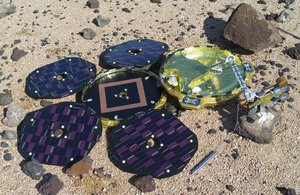UK-led Beagle 2 lander found on Mars
Beagle 2 successfully landed on Mars on 25th December 2003.

Beagle 2 model on a simulated Mars surface.
The UK-led Beagle 2 Mars Lander, thought lost on Mars since 2003, has been found partially deployed on the surface of the planet, ending the mystery of what happened to the mission more than a decade ago. This find shows that the Entry, Descent and Landing (EDL) sequence for Beagle 2 worked and the lander did successfully touchdown on Mars on Christmas Day 2003. Beagle 2 hitched a ride to Mars on ESA’s Mars Express mission and was a collaboration between industry and academia. It would have delivered world-class science from the surface of the Red Planet. Many UK academic groups and industrial companies contributed to Beagle 2.
Images taken by the HiRISE camera on NASA’s Mars Reconnaissance Orbiter (MRO) and initially searched by Michael Croon of Trier, Germany, a former member of ESA’s Mars Express operations team at ESOC, have identified clear evidence for the lander and convincing evidence for key entry and descent components on the surface of Mars within the expected landing area of Isidis Planitia (an impact basin close to the equator).
Since the loss of Beagle 2 following its landing on Christmas Day 2003, Michael has, in parallel with members of the Beagle 2 industrial and scientific teams, been patiently screening images from HiRISE looking for signs of Beagle 2. Subsequent re-imaging and analysis by the Beagle 2 team, HiRISE team and NASA’s Jet Propulsion Laboratory (JPL) has confirmed that the targets discovered, are of the correct size, shape, colour and dispersion (i.e. separation) to be Beagle 2.
Dr David Parker, Chief Executive of the UK Space Agency, said:
The history of space exploration is marked by both success and failure. This finding makes the case that Beagle 2 was more of a success than we previously knew and undoubtedly an important step in Europe’s continuing exploration of Mars.
The images, following analysis by members of the Beagle 2 team and NASA, show the Beagle 2 lander in what appears to be a partially deployed configuration, with what is thought to be the rear cover with its pilot/drogue chute (still attached) and main parachute close by. Due to the small size of Beagle 2 (less than 2m across for the deployed lander) it is right at the limit of detection of imaging systems (cameras) orbiting Mars. The targets are within the expected landing area at a distance of ~5km from its centre. Several interpretations of the image of the lander have been identified, consistent with the lander’s size and shape. The imaging data is however consistent with only a partial deployment following landing. This would explain why no signal or data was received from the lander – as full deployment of all solar panels was needed to expose the RF antenna which would transmit data and receive commands from Earth.
Professor Mark Sims of the University of Leicester who was an integral part of the Beagle 2 project from the start leading the initial study phase and was Beagle 2 Mission Manager and led the Flight Operations team said:
I am delighted that Beagle 2 has finally been found on Mars. Every Christmas Day since 2003 I have wondered what happened to Beagle 2. My Christmas day in 2003 alongside many others who worked on Beagle 2 was ruined by the disappointment of not receiving data from the surface of Mars. To be frank I had all but given up hope of ever knowing what happened to Beagle 2. The images show that we came so close to achieving the goal of science on Mars. The images vindicate the hard work put in by many people and companies both here in the UK and around Europe and the world in building Beagle 2. The highly complex entry, descent and landing sequence seems to have worked perfectly and only during the final phases of deployment did Beagle 2 unfortunately run into problems. I view it as a great achievement that the team built Beagle 2 in a little over 4 years and successfully landed it on the surface of Mars. It was a great pity we couldn’t have delivered the world class science Beagle 2 may have brought and even sadder that Colin (Pillinger) and other colleagues who died in 2014 didn’t live to see the discovery that Beagle 2 made it to Mars. Beagle 2 showed the fantastic innovation skills available from UK academia and industry and inspired many people in particular the young. Many opportunities exist for the UK, working with other countries to do inspired space exploration and science (subject of course to available funding).
Unfortunately given the partial deployment (and covering of the RF antenna) it would not be possible to revive Beagle 2 and recover data from it. Professor Colin Pillinger from the Open University who led the Beagle 2 project with inspirational enthusiasm died in May 2014. Others that provided major contributions to Beagle 2 were Professor George Fraser of the University of Leicester and Professor David Barnes of Aberystwyth University who also died in 2014.